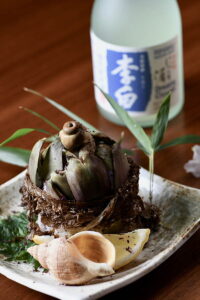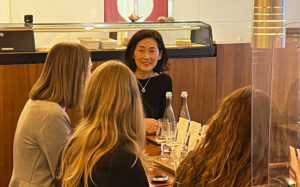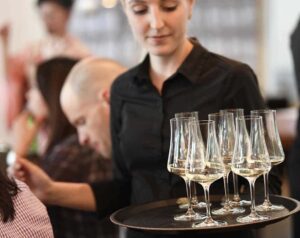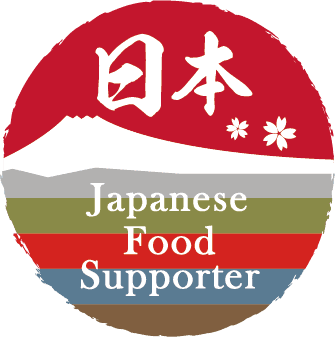What categories & classifications are there for Japanese sake?

Currently there are in Japan about 1,400 sake breweries and it is said that there are more than 10,000 different kinds of sake are produced. Even if the number of products imported into Europe Sake is still very limited, it is often not easy for beginners to find their way around the world of different sake.
To understand this variety and find the sake that tastes best to oneself, the Japanese quality designations or sake categories are an important guide.
Premium or non-premium sake. What is the difference?
Sake can first be roughly divided into premium and non-premium sake.
Premium sake belongs to the category of Tokutei Meishōshu (特定名称酒) as defined by the Japanese Alcohol Tax Law.
Sake that does not fall into this category is non-premium sake, which in Japan is called "Futsūshu" (普通酒).
You may have heard of the terms "Junmai" or "Ginjō". These are designations for sake that meets certain criteria for ingredients and production methods.
Thus, choosing a premium sake already guarantees a certain level of quality. In addition, knowing the different categories of premium sake will give you a general idea of the brewing method and the flavor of each sake.
The premium categories for Japanese sake: Tokutei Meishōshu
"Tokutei Meishōshu" in German translated from Japanese means something like "sake with special designations".
Only about 40 % of the sake produced in Japan can boast the Tokutei Meishōshu quality designation, and they must meet a set of strict criteria, including the following
- No ingredients other than Rice, Kōji, Water and (if necessary) brewing alcohol are used.
- The quality of the rice used must be above a certain level (3rd grade or higher in rice inspection).
- Of the rice used, the proportion of Kōji rice must be at least 15 %.
- Rice must be polished to a certain degree.
- The color, aroma and taste of the final product must be good.
Rice polishing degree central factor for taste and quality of sake
In sake production, the outside of the rice grain is usually scraped off. Sake brewers refer to this as "polishing" the rice. The outside of the rice grain contains nutritious components such as protein and fat. However, these components can affect the taste and flavor of the sake.
Therefore, the outer layer of the rice grain is removed and only the part of the rice closer to the center, called "shinpaku" (心白, starch core), is used to brew sake.
How much of the outer layer of the rice has been polished is quantified in a number called the "degree of polish."
This is a weight equivalent. So if 30 % of rice has been removed from the brown rice, the percentage of rice remaining is indicated, e.g. "70 % degree of polishing". The rice that has a degree of polishing of 70 % thus weighs 30 % less after polishing than before, and thus also provides a mass of raw material for sake that is reduced - in this case by 30 %.
By using rice that has been evenly polished down to a remaining "shinpaku" (starch core), a clear, elegant aroma and clean taste with a pleasant aftertaste is achieved.
Of course, the quality of the rice itself also plays a role. But since the process of polishing rice is labor intensive and expensive, and at the same time more rice is needed to produce a certain amount of sake, the more of the rice that has been polished away, the more the price of the sake naturally increases.
Thus, a sake with a polishing grade of 35 % (where 65 % of the rice grain has been polished away) is much more expensive than a sake with a polishing grade of 60 % (where 40 % of the rice grain has been polished away).
In order to avoid confusion of terms (degree of polishing - how much was polished), we designate in the Restaurant sansaro the degree of polishing of our premium sake in our beverage list with "polished to XX %" - so you can best imagine that in a sake with a degree of polishing of 23 % actually only 23 % of the original rice grain was used and not just 23 % polished away.
Premium sake classifications
Premium sake are basically divided into six classes, which differ in rice polishing degree and the addition of brewing alcohol.
Strictly speaking, however, there are eight classes if you add the refinements "Tokubetsu-Junmai" (特別純米) and "Tokubetsu-Honjōzō" (特別本醸造) as classes of their own, as is officially the case in Japan.
Why is brewing alcohol added to some sake?
You probably already know that Sake made from rice will.
However, there are basically two types of sake:
one made only from rice, Kōji and water,
and the other with the addition of brewing alcohol.
The addition of brewing alcohol may initially associate the impression of inferior quality for sake novices - but this would be a mistake. This is because the brewing alcohol is not used to increase the volume of the sake, but to raise the level of flavor and further refine the aroma of the sake.
The raw materials used to produce brewing alcohol are mainly from natural sources such as sugar cane and are high quality alcohol. So, brewing alcohol is added to the sake to adjust the taste and make it light and refreshing to drink without affecting the natural aroma and flavor of the sake.
So it is important to understand: the addition of brewing alcohol does not automatically make sake cheap or bad. On the contrary, two of the top categories of sake (Ginjō and Daiginjō) exactly such sake with added brewing alcohol.
It depends more on the quality of the ingredients and the quality and attention of the manual work in the production process.
Junmai, Junmai Ginjō and Junmai Daiginjō: sake without added brewing alcohol
Junmai (純米), Junmai Ginjō (純米吟醸) and Junmai Daiginjō (純米大吟醸) are sake made only from rice, Kōji and water.
Junmai (純米) is a sake made only from rice, Kōji and water.
There are no requirements for the degree of rice polishing for this class. If the rice used is polished to 60 % or less, or if it is brewed by a special process, it can be called "Tokubetsu-Junmai" (特別純米).
Junmai Ginjō (純米吟醸) is made from the same ingredients as Junmai, but the rice used must be polished below 60 % of the original weight.
In addition, the sake is brewed with a special fermentation method called "Ginjō-zukuri" (吟醸造り).
Junmai Daiginjō (純米大吟醸) is a higher grade of sake than Junmai Ginjō, and the rice used must be polished down to at least 50 %.
Honjōzo, Ginjō and Daiginjō: sake with added brewing alcohol
In Honjōzo (本醸造), Ginjō(吟醸) and Daiginjō(大吟醸), brewing alcohol is added during the production process in addition to rice, Kōji and water.
Honjōzō (本醸造) is a sake to which brewing alcohol may be added during the brewing process up to 10 % of the total weight of the rice. The rice used must be polished below 70 % of the original weight. If the rice used is polished to 60 % or less, or if it is brewed by a special process, it may be called "Tokubetsu-Honjōzō" (特別本醸造).
Ginjō (吟醸) is brewed in the same way as Honjōzō, but with Ginjō method. The rice must be polished down to at least 60 %.
Daiginjō (大吟醸) is a higher grade of sake than Ginjō, and the rice used must be polished to at least 50 % of the original weight.
Non-premium sake: Futsūshu
Sake that does not fall under the category of "Tokutei Meishōshu" is commonly referred to as ".Futsūshu" (literally: normal sake). However, these are common names that are not usually listed on the bottle label. Most are industrially produced, and there are no restrictions on the rice used or the degree of polishing. This means that the rice used may not have passed the quality test and the degree of polishing may be more than 71 %.
In addition, this category of sake can be added sweeteners, acidifiers and amino acids. Almost 60% of the sake produced in Japan is Futsūshu, which is much cheaper in price than premium sake, but the quality varies considerably.

Just for cooking: Ryōrishu
By the way, there is also: Ryōrishu (料理酒), is a sake used exclusively for cooking.
Just as Europeans use wine for cooking, sake is used for Japanese food. In cooking, sake helps to remove unpleasant odors from ingredients, thus making them milder, and adds depth to the flavor.
Cooking sake and "drinking" sake look the same, but cooking sake may contain additives of salt and sugar, so it is best not to drink it.
As far as we know, some Japanese restaurants in Munich have also served cooking sake for drinking as hot sake. This is by no means harmful to health - but can you taste the difference?
Remember: good sake needs a lot of handwork and therefore has its corresponding price.
| Designation | Ingredients | Polishing grade | Brewing method | Flavor |
|---|---|---|---|---|
| Junmai | Rice Kōji Water Yeast |
free | normal | -rich in umami -full-bodied |
| Tokubetsu Junmai | under 60 % or special method | -fruity and mild | ||
| Junmai Ginjō | under 60 % | Ginjō-zukuri | ||
| Junmai Daiginjō | under 50 % | Ginjō-zukuri | -fruity and rich in umami -aromatic and rich |
|
| Honjōzō | Rice Kōji Water Yeast + Brewing alcohol |
under 70 % | normal | -fresh and light |
| Tokubetsu Honjōzō | under 60 % or special method | -fruity and floral -light and clear |
||
| Ginjō | under 60 % | Ginjō-zukuri | ||
| Daiginjō | under 50 % | Ginjō-zukuri | -fruity and floral -highly aromatic and smooth |
|
Other special categories for the differentiation of sake
In addition to the premium sake categories, there are several other categories of sake. The differences between these types are based on minor differences in production methods. These minor differences give sake a wide variety of flavors and aromas, which is one of the characteristics of sake.
- Namazake 生酒 - "raw" sake - not or less pasteurized, more lively, but also keeps less well, is considered fresh and particularly interesting.
- Nigorizake にごり酒 - naturally cloudy sake
- Taruzake 樽酒 - a sake aged in wooden barrels, usually made of Japanese cedar. It has the remarkable aroma of the wood.
- Shinshu 新酒 literally means "new sake", but has three different meanings
- Koshu 古酒- is "aged sake" that has been stored for some time in a barrel or bottle
- Kijōshu 貴醸酒- a luxurious sake, which is added to the main mash instead of water finished sake. Sweet, velvety and very rare.
- Muroka Genshu 無濾過原酒 - a sake that is not filtered after pressing and not blended with water. Muroka Genshu has a stronger alcohol content and a strong taste.
- Sparkling Sake スパークリング酒 - so to speak, a counterpart to champagne, sake, to which carbon dioxide was either added or where the bubbling gases were created in the brewing process.
- Amazake甘酒 - literally means sweet sake. It is called sake because it is made in a sake brewery almost like sake, but according to Japanese legal regulations it is not actually sake. Amazake is a non-alcoholic, very healthy drink and is popular for seasonal festivities or for children to drink.
Do you know any other classifications or production methods? We can not know everything and the world of sake is wide -. let us know, if there are other, important or exciting sake categories.
Or just come to our restaurant sansaro and enjoy different sake personally...
Sharing pleasure in Japanese
SUSHIYA is passionate about Japanese cuisine and culture. In our restaurant sansaro you can encounter the fascinating Japanese cuisine or have it delivered to your home. On our homepage, Facebook and Instragram we always give insights into news and interesting topics.

Sake Tasting Event on May 5, 2019 at Restaurant sansaro
Our kitchen team is already busy preparing for the Sake Tasting at the restaurant sansaro in Munich on May 5, 2019

Mini Sake Tasting March 17 2022
On March 17, we had the opportunity to celebrate the end of a day of workshops by a small but nice business group with a small,

Review Sake Tasting with Food Pairing on May 1, 2018
Review of the sake tasting on May 1, 2018 at the sushi restaurant sansaro in Munich - where you can get to know Japanese sake and combine it with the right food.



